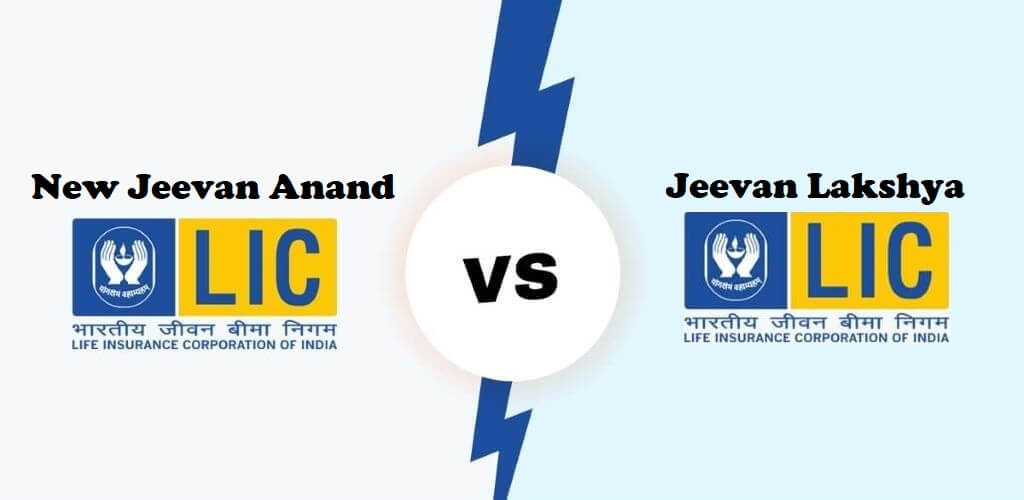The Life Insurance Corporation of India (LIC) offers a wide variety of insurance policies that have been designed based on customer needs and budgetary constraints. Two of its plans, the LIC Jeevan Umang and LIC New Jeevan Anand, were created with the purpose of providing security to the insured’s family after his or her passing.
But for some people, especially those who are not familiar with the fundamentals of a life insurance policy, choosing any one of them may be complicated. To assist you in selecting the life insurance plan that best meets your needs, this post compares Jeevan Umang and Jeevan Anand in great depth.
What Is LIC's Jeevan Umang Plan?
A whole life insurance plan called Jeevan Umang from LIC was developed to give the insured’s family financial comfort and safety while he or she is gone. This plan offers yearly survivor benefits from the end of the premium-paying term until the time of maturity. In addition, a lump sum payout is given in the event of the policyholder’s demise during the policy term or at policy maturity.
What Is LIC's New Jeevan Anand Plan?
A non-linked, participating individual life assurance plan called Jeevan Anand from LIC offers the highest level of protection and savings. The plan’s two benefits—a complete payout at maturity and continued lifelong coverage—are its main selling point.
This combination offers the policyholder lifetime financial protection against death with the promise of a lump sum payout at the end of the selected policy term in the event of the policyholder’s survival. The user has access to a lending facility within the plan as well.
Eligibility Criteria Of LIC’s Jeevan Umang & LIC’s New Jeevan Anand
| Parameters | LIC’s Jeevan Umang | LIC’s New Jeevan Anand |
| Minimum Entry Age | 90 Days (Completed) | 18 Years (Completed) |
| Maximum Entry Age | 55 Years (Nearer Birthday) | 50 Years (Nearer Birthday) |
| Policy Term | (100 Minus Age At Entry) Years | 15 To 35 Years |
| Minimum Basic Sum Assured | Rs. 2,00,000 | Rs. 1,00,000 |
| Maximum Basic Sum Assured | No Limit | |
| Maturity Age | 100 Years (Nearer Birthday) | 75 Years (Nearer Birthday) |
Comparison Of Features & Benefits Of LIC’s Jeevan Umang & LIC’s New Jeevan Anand Plans
Even though each of the plans has features and benefits of its own, it’s important to examine them closely to see how they differ and overlap.
Death Benefits:
Both plans offer “Sum Assured on Death,” vested “Simple Reversionary Bonuses,” and “Final Additional Bonus,” if any, in the event that the life assured passes away during the policy term, provided the policy is in place and all required premiums have been paid.
The “Sum Assured on Death” under both the plans are as follows:
Jeevan Umang Life Insurance Plan From LIC
- 7 X Annualized Premium
New Jeevan Anand Life Insurance Plan From LIC
- 125% of the Basic Sum Assured
- 7 X Annualized Premium
It is important to note that a minimum of 105 percent of the premiums paid up until the date of death must be included in this death benefit.
Maturity Benefits:
The “Sum Assured on Maturity” and any vested “Simple Reversionary Bonuses” and “Final Additional Bonuses” will be paid if the life assured survives the policy period and the policy is still in force. The ‘Basic Sum Assured’ is the value of this maturity benefit, which is available under both plans.
Survival Benefits:
This benefit is offered through the Jeevan Umang life insurance plan from LIC. If the life assured survives to the end of the premium-paying term and all necessary premiums have been paid, an annual survival bonus equal to 8% of the “Basic Sum Assured” will be given.
The first payment for the survival benefit is made at the end of the premium-paying period, and further payments are given at the end of each consecutive year, or, if sooner, on the anniversary of the policy before the date of maturity, providing the life assured survives.
Rider Options:
For expanding needs, the regular coverage may not always be adequate. As a result, the policyholder can add rider choices to either plan by paying an additional premium. The following are the rider options offered by both plans:
LIC’s Jeevan Umang
- Accidental Death & Disability Benefit Rider
- Accident Benefit Rider
- New Term Assurance Rider
- New Critical Illness Benefit Rider
- Premium Waiver Benefit Rider
LIC’s New Jeevan Anand
- Accidental Death & Disability Benefit Rider
- Accident Benefit Rider
- New Term Assurance Rider
- New Critical Illness Benefit Rider
Grace Period:
Under both plans, for the payment of yearly, half-yearly, or quarterly premiums, a grace period of 30 days is provided, and for monthly premiums, a grace period of 15 days from the date of the first unpaid premium is offered.
The policy will be regarded as continuing to provide risk coverage throughout this time, in accordance with the provisions of the policy, without interruption. The policy expires if the premium is not paid before the days of grace have passed.
Rebates:
Rebate is the discount that the insurance company gives the policyholder when they purchase a policy. The policyholder receives refunds in the form of a percentage of the premium or the agent’s commission. Simply said, the rebate allows the policyholder to save some money.
Both LIC’s Jeevan Umang and New Jeevan Anand plan offer rebates on higher sum assured amounts. The rebate rates are as follows:
| Basic Sum Assured (B.S.A.) | Rebate (In Rs.) |
| LIC New Jeevan Anand | |
| 1,00,000 To 1,95,000 | Nil |
| 2,00,000 To 4,95,000 | 1.50% Of BSA |
| 5,00,000 & 9,95,000 | 2.50% Of BSA |
| 10,00,000 & Above | 3.00% Of BSA |
| LIC Jeevan Umang | |
| 2,00,000 To 4,75,000 | Nil |
| 5,00,000 To 9,75,000 | 1.25% Of BSA |
| 10,00,000 To 24,75,000 | 1.75% Of BSA |
| 25,00,000 & Above | 2.00% Of BSA |
Suicide Exclusions:
Suicide is excluded from both plans under the following situations:
- If the insured commits suicide within a year (12 months) of acquiring the coverage, the firm is required to pay the claim. However, the company would pay 80% of the total premiums given if the premium payment was made on time.
- If, however, the person commits suicide within a year of the revival date, the corporation will not compensate him/her in any way. If the person has already paid the premiums, the family members will likely receive 80% of what was paid.
Sample Benefit Illustration Of LIC’s Jeevan Umang Plan & LIC’s New Jeevan Anand Plan
Benefit summaries for each of the two plans are required in order to select the best one. It will be useful in predicting how both plans will perform during the course of their coverage. As a result, this section will provide a thorough explanation of the benefits offered by both plans.
LIC’s Jeevan Umang
Take Akshara, a 25-year-old who purchased the Jeevan Umang life insurance plan from LIC, as an example. The following are the policy’s specifics:
- Policy Term: 25 Years
- Premium Paying Term: 30 Years
- Premium Payment Mode: Yearly
- Basic Sum Assured: Rs. 5,00,000
- Premium (Excluding Taxes): Rs. 14,758
The following are the benefits offered by the plan’s several situations!
| End of Year | Total Premium Paid Till the End Of The Year (Rs.) | Guaranteed Benefits | Non-Guaranteed Benefit | Total Maturity Benefit | Total Death Benefit | |||||
| Survival Benefit | Sum Assured On Death | Sum Assured On Maturity | (Simple Reversionary Bonus) | |||||||
| @4% PA | @8% PA | @4% PA | @8% PA | @4% PA | @8% PA | |||||
| 5 | 73,925 | 0 | 5,00,000 | 0 | 0 | 1,07,500 | 0 | 0 | 5,00,000 | 6,07,500 |
| 10 | 1,47,850 | 0 | 5,00,000 | 0 | 0 | 2,15,000 | 0 | 0 | 5,00,000 | 7,15,000 |
| 20 | 2,95,700 | 0 | 5,00,000 | 0 | 0 | 4,30,000 | 0 | 0 | 5,00,000 | 9,47,500 |
| 40 | 4,43,550 | 40,000 | 5,00,000 | 0 | 0 | 7,52,500 | 0 | 0 | 5,00,000 | 21,40,000 |
| 60 | 4,43,550 | 40,000 | 5,00,000 | 0 | 0 | 9,67,500 | 0 | 0 | 5,00,000 | 43,12,500 |
| 65 | 4,43,550 | 40,000 | 5,00,000 | 0 | 0 | 10,21,250 | 0 | 0 | 5,00,000 | 50,03,250 |
| 70 | 4,43,550 | 40,000 | 5,00,000 | 0 | 0 | 10,75,000 | 0 | 0 | 5,00,000 | 56,86,000 |
| 75 | 4,43,550 | 0 | 5,00,000 | 5,00,000 | 0 | 11,28,750 | 5,00,000 | 63,08,250 | 5,00,000 | 63,08,250 |
LIC’s New Jeevan Anand
Let’s take the 30-year-old man Mr. Y as an illustration. He has chosen the following information when purchasing the New Jeevan Anand life insurance policy:
- Policy Term: 35 Years
- Premium Payment Mode: Yearly
- Basic Sum Assured: Rs. 1 Lakh
- Premium: Rs. 3,165
The following table displays how the plan works for Mr. Y in terms of benefits!
| End Of Year | Total Premiums Paid Till The End Of The Year | Guaranteed Benefits | Non-Guaranteed Benefits | Total Maturity Benefits | Total Death Benefits | ||||
| Sum Assured On Maturity | Sum Assured On Death | @4% PA | @8% PA | @4% PA | @8% PA | @4% PA | @8% PA | ||
| 5 | 15,825 | 0 | 1,25,000 | 2,000 | 16,000 | 0 | 0 | 1,27,000 | 1,41,000 |
| 20 | 63,300 | 0 | 1,25,000 | 8,000 | 64,000 | 0 | 0 | 1,33,000 | 1,91,500 |
| 30 | 94,950 | 0 | 1,25,000 | 12,000 | 96,000 | 0 | 0 | 1,37,000 | 2,45,000 |
| 35 | 1,10,775 | 1,00,000 | 1,25,000 | 14,000 | 1,12000 | 114000 | 256000 | 1,39,000 | 2,81,000 |
| 36 Onwards | 1,10,775 | 0 | 1,00,000 | 0 | 0 | 0 | 0 | 1,00,000 | 1,00,000 |
Which Is Better: LIC’s Jeevan Umang OR LIC’s New Jeevan Anand Plan?
There is no denying the fact that the two insurance policies are suitable enough for any individual.
The LIC Jeevan Umang plan is the best choice if you want to ensure annual benefits and lifelong coverage. There is, however, one significant flaw. There is only one yearly choice available, and receiving the survival advantages occurs at a predetermined frequency. It also doesn’t take inflation into consideration.
The New Jeevan Anand life insurance plan from LIC, on the other hand, would be a better option if you want lifelong protection and want the insurance to remain in effect after it matures. Its dual benefit of whole life insurance and endowment policy is also remarkable. However, just like the LIC Jeevan Umang plan, LIC New Jeevan Anand comes with its own sets of cons, such as a limited lock-in period and insufficient maturity benefit at the end of the policy term.
Therefore, you can review their policy brochures to assess their features, terms, conditions, and more to determine the benefits and drawbacks of each insurance, or you can utilize the comparison on this page to assist you in making your decision.
Before making a choice, it is also strongly recommended to read the reviews of the two plans. Instead of reading reviews on social media platforms like ‘Quora,’ speak with qualified financial advisers who have experience and can offer you individualized recommendations.







